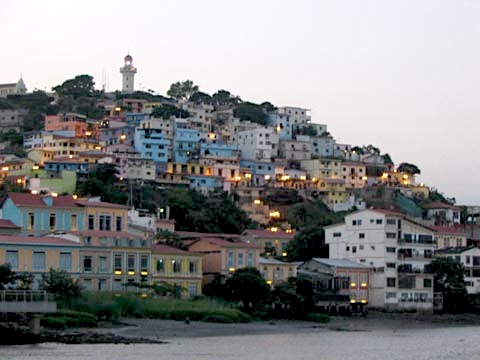
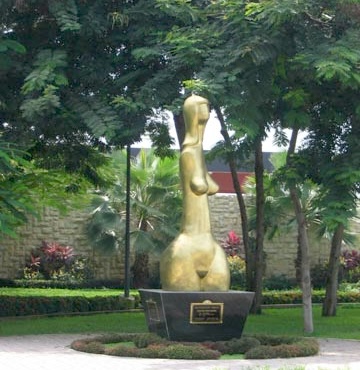
Gail traveled to the city of Guayaquil in Ecuador at the end of May 2007 to teach English at the Center Ecuadoran North American (CEN) for a month. She got a room in the home of a sculptress, Doña Yela Loffreto, who is famous in Ecuador. In this photo from a boat on the River Guayas, Doña Yela's home is the large white building near river on the right side. At the top of the hill at the left, Cerro Santa Ana, you can see the historic light house and Church of the Santa Ana. The colorful houses climbing the hill belong to the Las Peñas district.

|
One of Doña Yela’s works is the Venus of Valdiva
|
Guayaquil has many picturesque sights.
|
The Las Peñas district lines the 444 steps from the Malecón 2000
up Cerro Santa Ana (Santa Ana Hill) to the terraces on which the church
and light house sit. The district includes restaurants and clubs, all of
which have to be provisioned by people carrying supplies up the stairs.
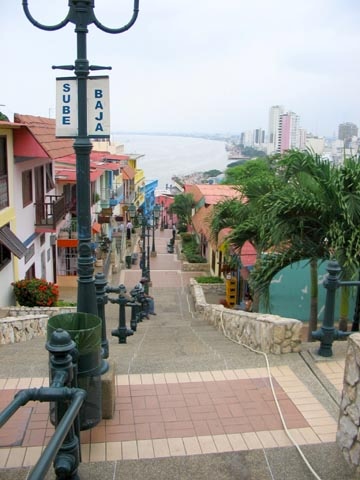
|
The Church of Santa Ana sits on the terrace just below the top of Cerro Santa Ana.
|
|
The lighthouse of Cerro Santa Ana stands at the top of the hill.
|
The Church of San Francisco on the plaza of the same name, which is next to the main street of Guayaquil, “ 9 de Octubre”. There are large advertisements on the Panasonic building behind the church.
|
|
The Palace of the Governor. The building occupies one block and features a large open corridor running through its middle. In the next block is the Guayaquil Municipal building which has a similar architecture.
|
These buildings feature large works of art that appear to be framed paintings on their sides.
|
One weekend, Gail took a 200-kilometer bus trip to the old city of Cuenca, a UNESCO World Heritage Site. While she was in Cuenca, she took a side trip to Ingapirca, the ruins of an Incan city.
|
Old Cathedral of Cuenca, whose construction began in the middle of the 1500s,
is now a museum of religious art.
|
She was surprised to find herself in the middle of Cuenca’s festival of
Corpus Christi. In the evening there were fireworks for the festival.
|
|
The setting of Ingapirca. Note the cattle on the hillside below the ruins.
|
This structure in Ingapirca is called "Temple of the Sun".
|
|
Close up of the Incan construction
|
Back at the CEN in Guayaquil, here Gail is with some of her students. The photo at the left is one of the classes. After the session ended, some students took her to a restaurant to celebrate. The photo at the right shows them. Among them was Fidel Castro, not an uncommon name here.
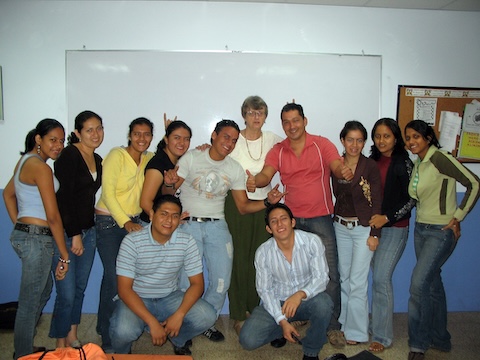
|
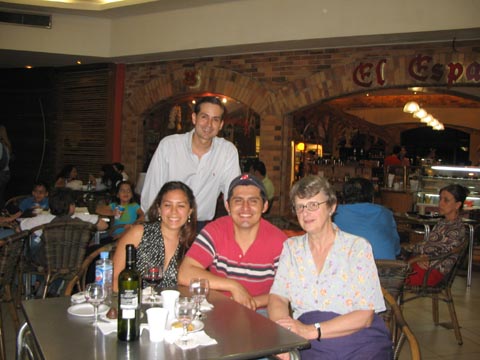
|
Al joined Gail on June 29 for an adventure trip to the Galápagos Islands. Before flying to the islands, we stayed at the Hotel San Rafael Plaza, seen in the left photo. Yellow taxi cabs, seen here, are very common on the streets. If the driver sees a North American on the sidewalk, he usually beeps his horn to indicate that he is available for hire. Guayaquil drivers use their horns a lot. The photo on the right is a typical shopping area. Most shops in Guayaquil are open to the street in front, like the shoe store to the left of this jewelry shop. At night an overhead metal door is brought down and padlocked to a bolt in the sidewalk to secure the store.
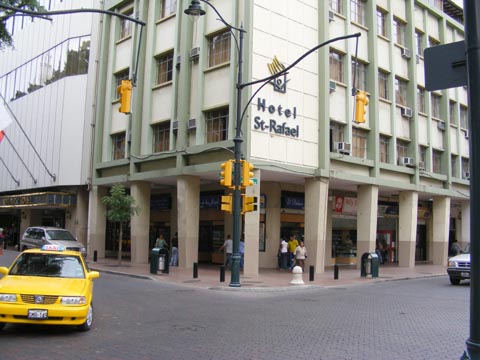
|
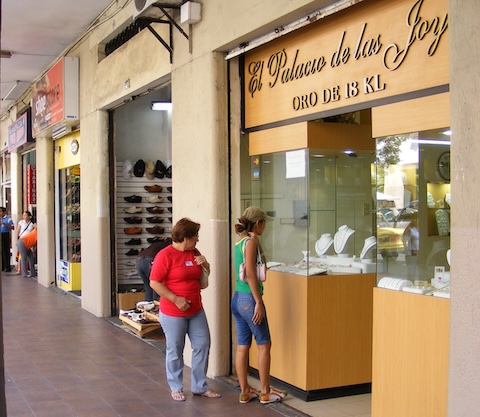
|
Before we left for the Galápagos, we visited two of the tourist sites in Guayaquil, the Parque Histórico Guayaquil and the Malecón 2000.
|
A woman visiting with Red-Lored Parrots at the entrance to
the Parque Histórico Guayaquil.
|
In an old street car in the Parque Histórico Guayaquil.
|
|
In one part of the Parque Histórico Guayaquil, they've recreated a city block as it would have been on the Malecón in the early years of the 20th century. This represents a wealthy family's house. The inset shows the ornate ceiling in the dining area upstairs.
|
In another part of the Parque Histórico Guayaquil,
they show how the rural farm workers would have lived.
This is a house made of bamboo.
|
Guayaquil is on the Guayas River, and the Malecón 2000 lines the bank of the river. Malecón means “dike”, holding the river out. It is part promenade, part amusement park and part shopping mall. It has museums and theaters and many food courts, especially below the surface.
|
This view shows some of the southern part of Malecón 2000 in the early evening. |
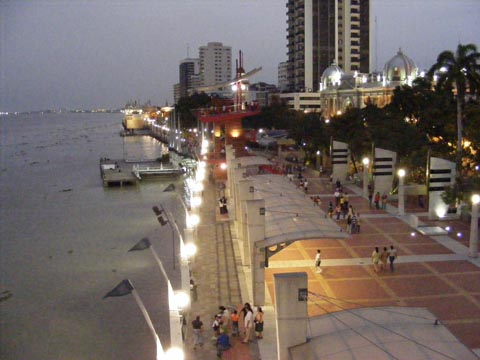
|
People enjoy the Pinguino ice cream stands on the Malecón 2000
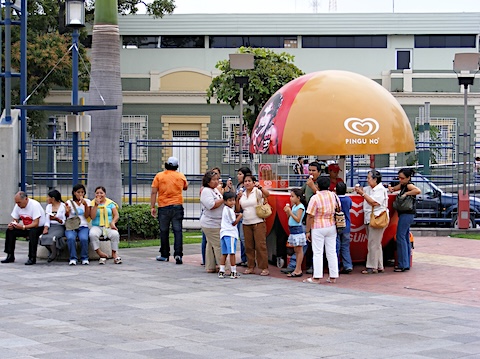
|
The Anthropological and Contemporary Art Museum on the Malecón
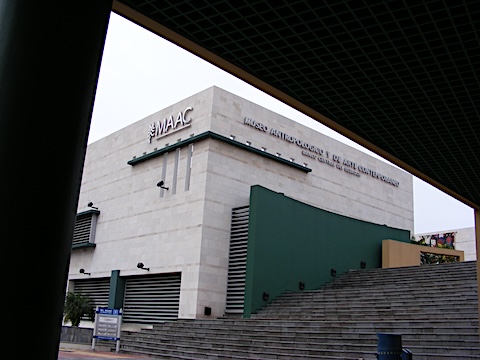
|
We flew from Guayaquil to the Galápagos on Monday, July 2. We ate a lunch served during the flight. From the airport on Baltra Island, we went by bus and ferry to Puerto Ayora on Santa Cruz Island. There we mingled with other newly arrived, slightly confused passengers on the dock. Each of us was looking for the one boat of many where we would have our adventure.
A motor boat (called a panga) took Gail and me out to La Fragata, a 75-foot motor yacht that was our home for the week. After depositing our gear in our cabin on the upper level of the boat, we were quickly treated to a second, and very filling, lunch. We met the other passengers and found eight of us were from the U.S., four from Germany, three from Canada, and one from South Africa. Six of us were in our 50s or 60s, nine in their 20s, and one a teenager. In addition to the tourists, La Fragata carried its captain with his crew of six men and Priscila, a young woman who was our guide and naturalist.
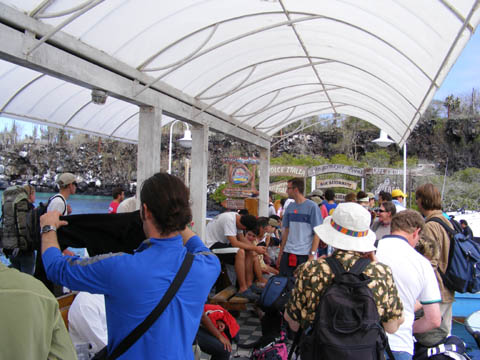
|
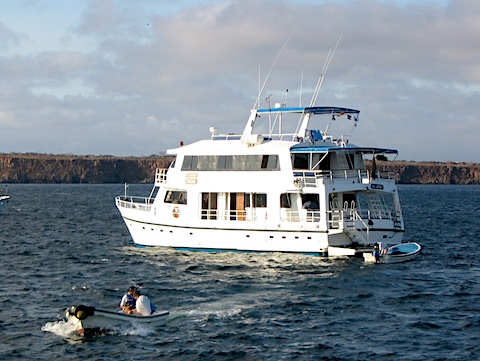
|
After lunch, our first activity of the cruise was to return to Puetro Ayora to visit the Darwin Research Station. There we met our only giant tortoises of the voyage. They were sleepy. Nearly all the animals and birds we saw on all the islands ignored our presence, not just those in captivity.
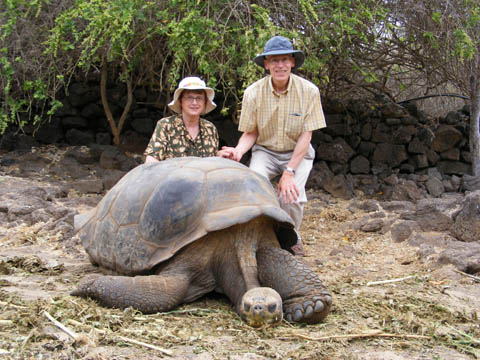
|
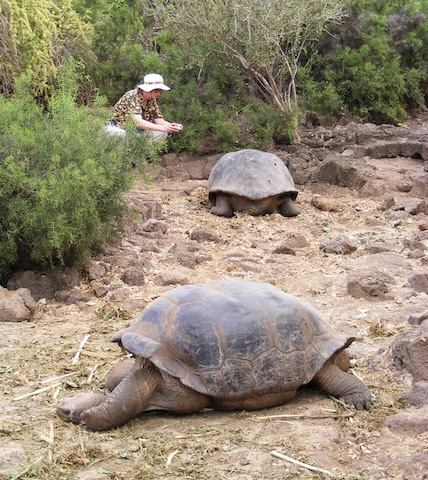
|
On Tuesday, we returned to Santa Cruz Island again for a bus trip halfway across the island. There we saw two large pits formed when rocks collapsed into giant bubbles formed in lava that flowed under the surface. The islands rose volcanically from the sea, like Hawaiʻi, in recent geological time. They still host active volcanoes.
Here we began to see the birds of Galápagos, including finches. The several species of finches, differing mostly in the size and shape of their beaks, in the Galápagos provide an important illustration of the power of natural selection. According to The Beak of the Finch by Jonathan Weiner even Darwin did not recognize this fully.
| Fellow passenger Markus at the edge of the larger pit. | A Galápagos finch in a tree near the pits on Santa Cruz Island. |
|---|---|
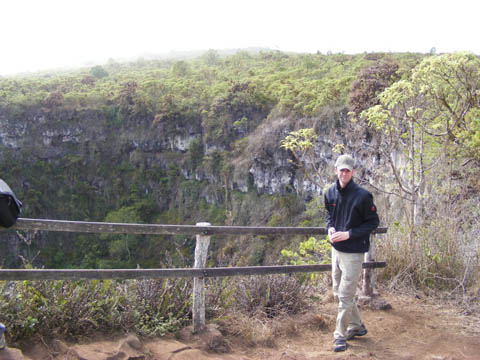
|
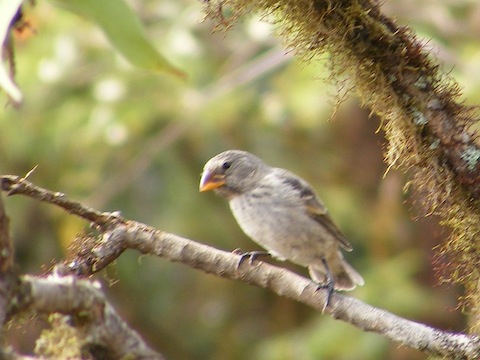
|
|
A colorful vermilion flycatcher near the second lava pit |
A different Galápagos finch species near the pits |
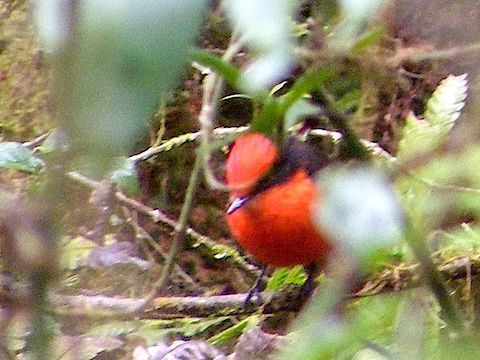
|
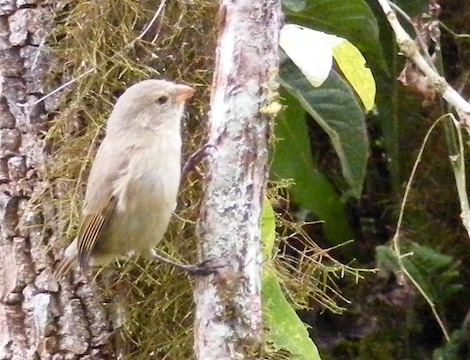
|
We cruised from Santa Cruz to Santa Fé Island after Tuesday’s lunch. During the voyage to Santa Fé, two frigatebirds used the air flow from the boat’s motion to soar along with us.
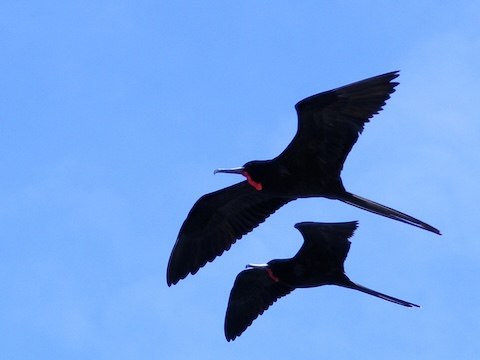
At Santa Fé, we went snorkeling for the first time. My camera is not waterproof so I did not take any photos. Some of the other passengers had brought disposable underwater cameras and I regreted not doing so. I did swim with sea lions, with schools of yellow-tailed surgeon fish, and with spctacular purple, orange and white king angel fish, among others. I could not see very well because I could not wear my glasses and because my face plate fogged up quickly. I wore a wetsuit, but got very cold in the water. Someone said the water temperature was 19 C (about 66 F). When I got back to the Fragata after an hour in the water, I was shaking so badly I could not hold the hot chocolate they gave us. Someone had to hold the cup so I could sip.
Tuesday night we cruised from Santa Fé to Española Isle. The waves were a little rough. Wednesday morning on Española, we were greeted by colorful Sally Lightfoot crabs, blue-footed boobies, marine iguanas, and sea lions. Both sea lions and the iguanas tended to lie upon or next to others of the same kind to preserve heat.
| Adult Sally Lightfoot crab at Suarez Point | Marine iguanas stacked for warmth |
|---|---|
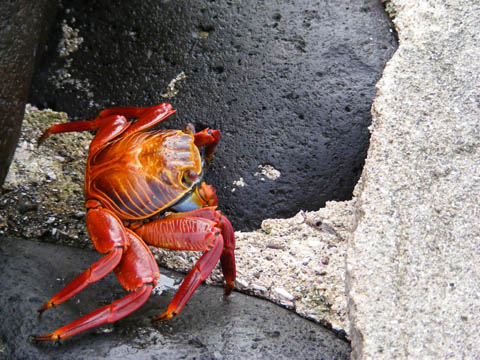
|
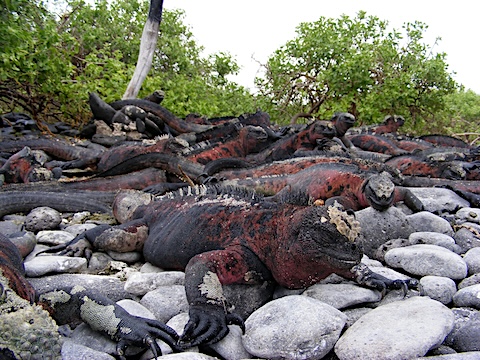
|
|
Gail with some of the sea lions |
Sea lions dozing with the Fragata's passengers in the background |
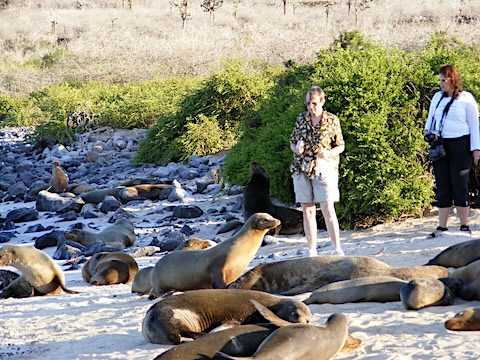
|
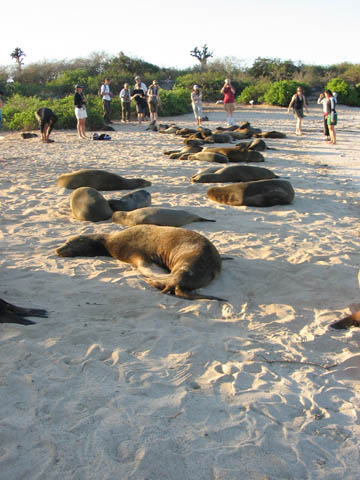
|
|
Sea lion with nursing pup |
More sea lions cuddled together |
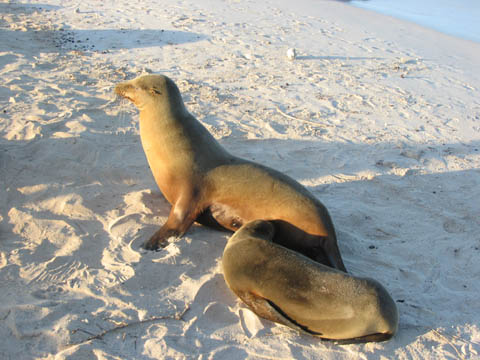
|
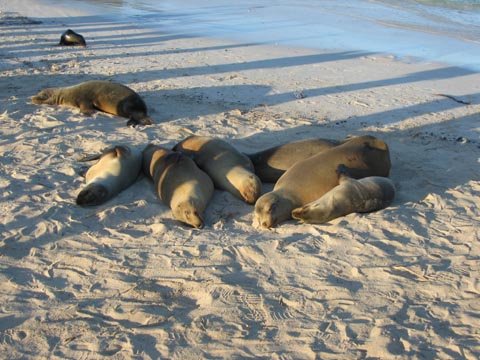
|
| Blue-footed boobies engaged in a courtship dance | Blue-footed booby and its chick |
|---|---|
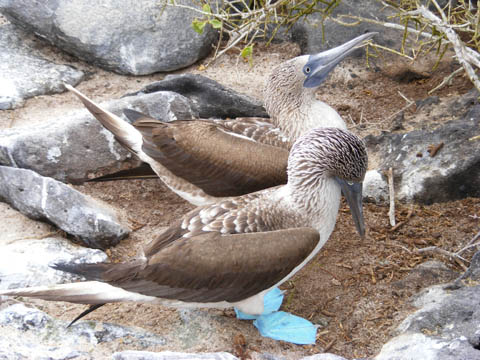
|
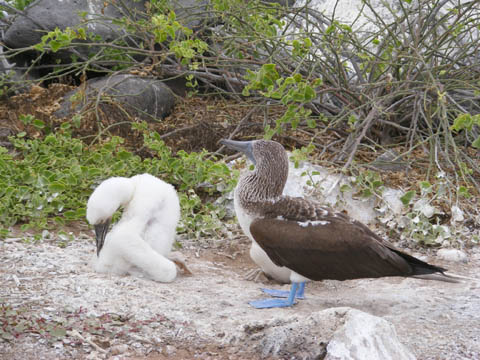
|
|
Albatross soaring along the edge of the cliff |
Albatrosses performing a courtship dance |
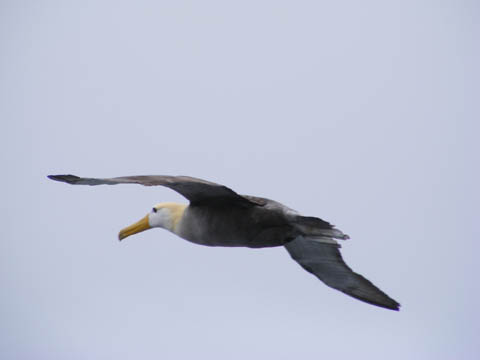
|
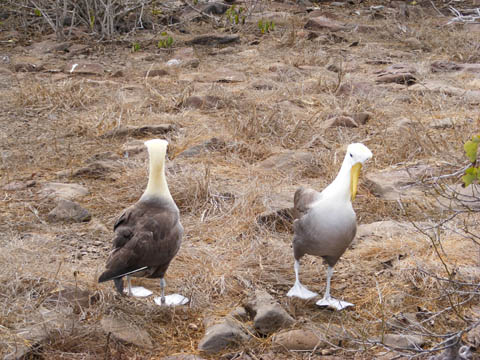
|
Click here to see a short video Gail made of the albatrosses’ courtship dance. Use your back arrow when the movie is done.
|
A Galápagos hawk about to fly |
|---|
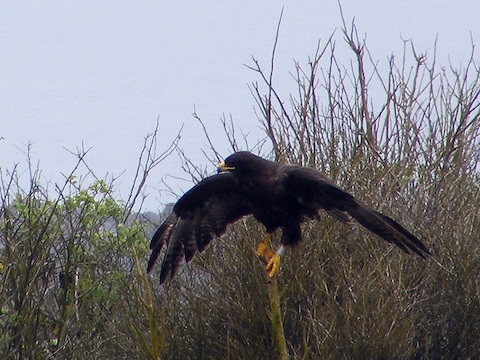
|
|
Some of the Fragata’s passengers with our guide watching birds nesting and soaring
|
Waves forced a spray of water out of a hole below the cliff where the albatrosses and boobies nested |
|---|---|
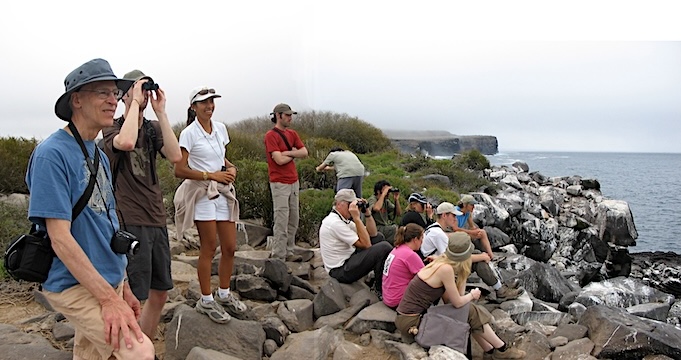
|
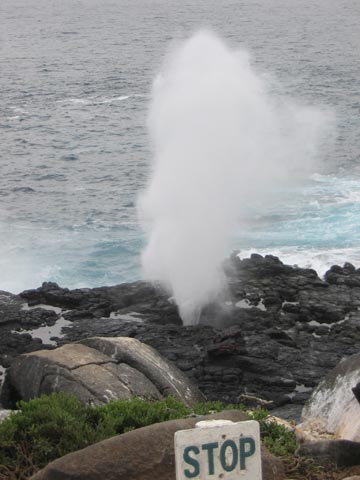
|
When the panga took us back to La Fragata, we saw a sea lion jumping out of the water, apparently just for the fun of it. We also saw marine iguanas swimming out to sea.
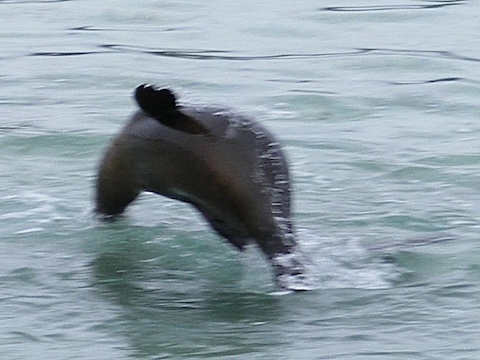
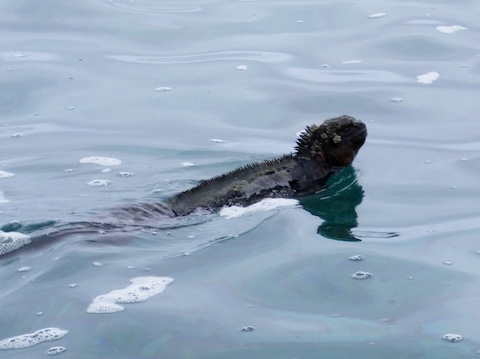
|
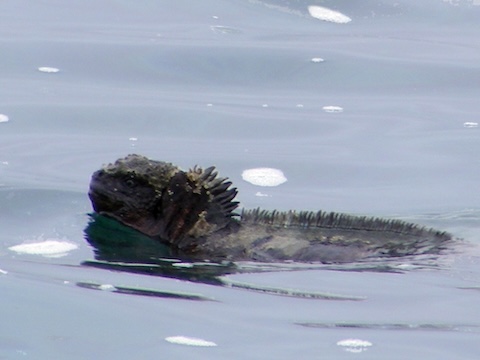
|
After lunch on July 4, we snorkled from the beach at Gardner Bay. I got cold again and returned to shore early. Others who stayed in the water saw small white-tipped sharks, rays, and even a swimming sea turtle.
Wednesday night we cruised from Española to Floreana Island. At night the sky was clear and dark. We could see many stars. The Milky Way was prominent. Jupiter shown brightly overhead in Scorpio. To the south we could see the Southern Cross and Alpha Centauri, the nearest bright star to our Sun. Terrific! I didn't get any pictures, but you can see the kite-shaped Southern Cross in the middle of this photo and Alpha Centauri on the left side.
Before we arrived at Floreana, the boat was accompanied by storm petrels, who appeared almost to be dancing upon the sea
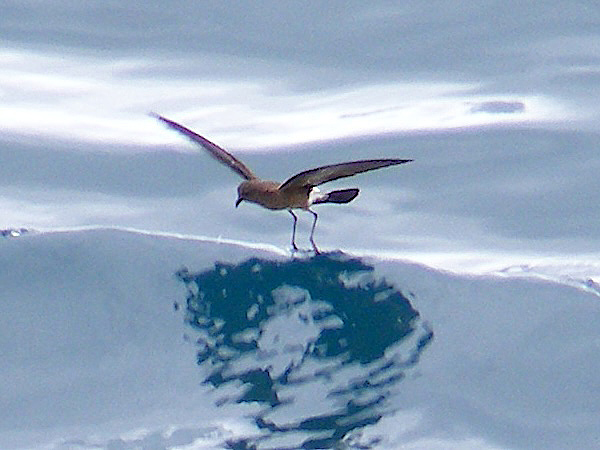
Some of the islands had docks or piers on which we could make a “dry landing”. To visit other islands, the pangas would be beached, we would step over the sides and then wade ashore. These were “wet landing”. Floreana was a wet landing.
| A wet landing on Floreana | The nest where a sea turtle laid her eggs and the trail she made to it |
|---|---|
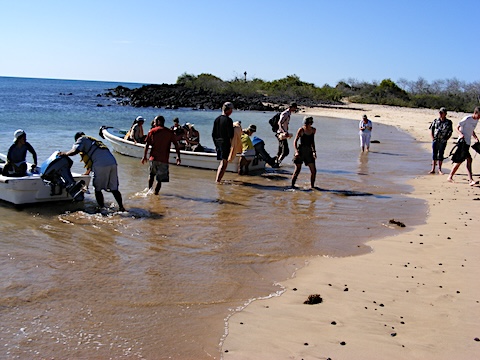
|
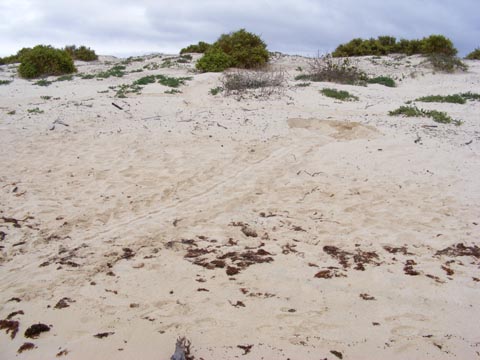
|
|
A sea lion (notice the ears) and a yellow warbler |
Floreana beach and La Fragata passengers |
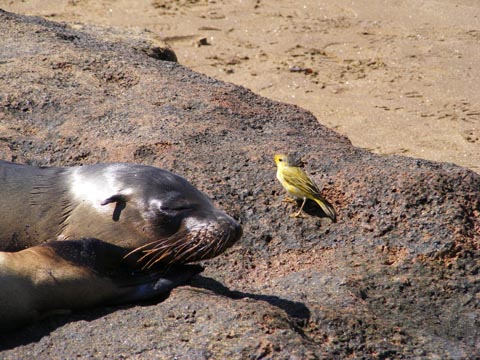
|
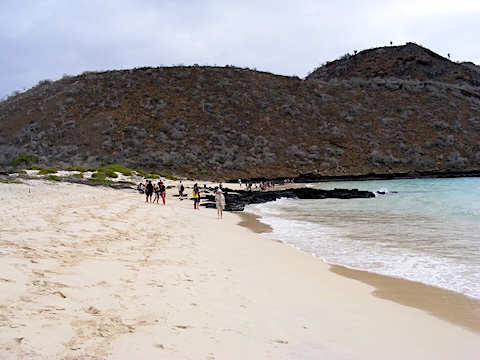
|
|
Flamingos in a lagoon at Punta Cormorãn on Floreana. |
|
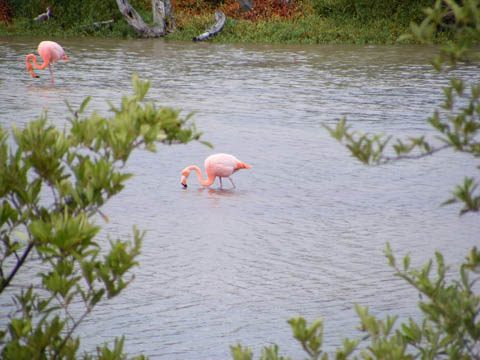
|
We snorkled for the third time at Corona del Diablo near Floreana Island. This was spectacular. There were all the kinds of fish we had seen before. In addition there were starfish - orange ones, blues ones, and some large black ones with colorful markings - sea urchins, coral, and many schools of small fish.
|
After our snorkeling adventure at the Devil’s Crown and while we ate lunch, La Fragata cruised to another beach on Floreana. Then the captain called to us that there were orcas ahead. We rushed onto the deck and could see the fins and spouts in the distance. As we drew closer, we could see a cloud of frigatebirds and storm petrels circling and occasionally diving to try to get a share of something in the water. At close range, we saw a floating carcass - someone said it was a sea turtle - with two whales coming up around it. One orca came up only about 15 feet from the side of the Fragata. It was exciting! I did not get any pictures of the orcas but two of the other passengers, Yoni and Marcus did. Here are three of their photos: |
|
|
Close up by Yoni |
The two orcas by Yoni |
|---|---|
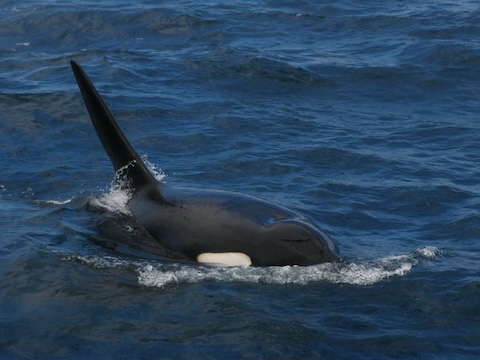
|
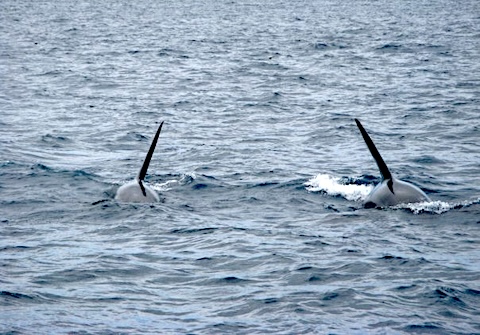
|
The Post Office on Floreana Island is a tradition that goes back to the early days of whaling from New England. Ships from New England would stop here to pick up and leave messages in a barrel for people on other ships. A sailor might get a message from family sent via another ship months or years after he left port. The Post Office might also be used to exchange information on whaling success.
After visiting the Post Office, and leaving messages, the passengers and crew played a game of football (soccer to us Americans).
| La Fragata’s passengers at the Post Office | The football game, with Moira and Jesse taking the ball |
|---|---|
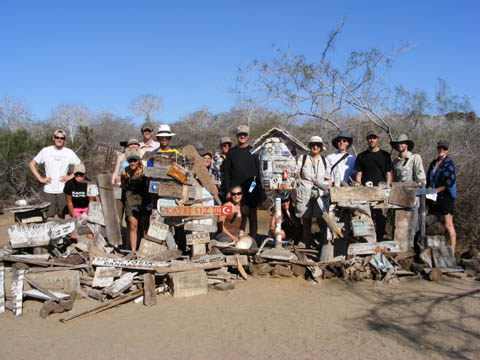
|
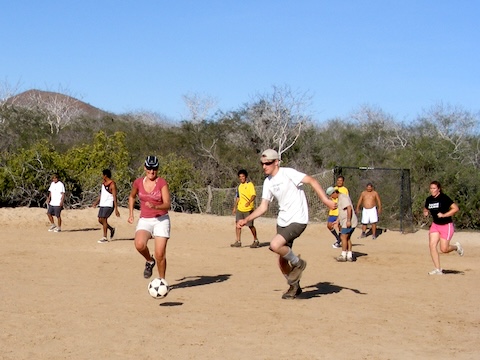
|
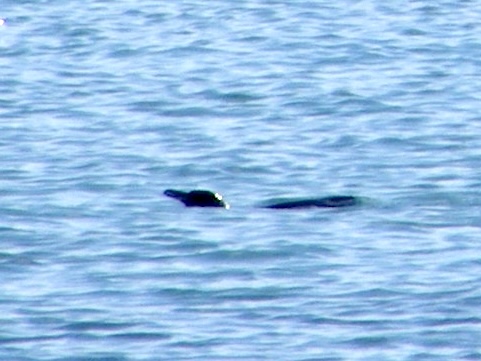
During the last night of our cruise, the Fragata took us north from Floreana to North Seymour, which is a small island just north of Baltra. We had our last excursion before breakfast on Friday.
| Sunrise on Friday morning at North Seymour | A booby chick |
|---|---|
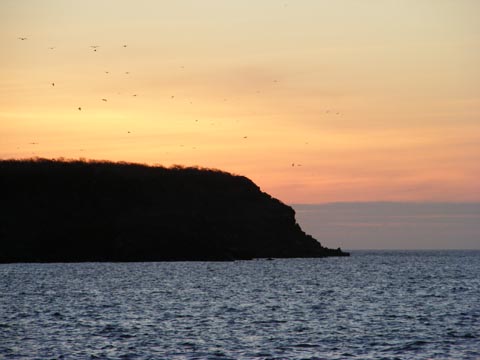
|
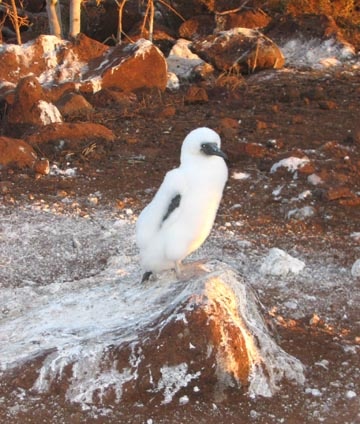
|
|
Male frigatebirds trying to attract a mate |
A soaring frigatebird |
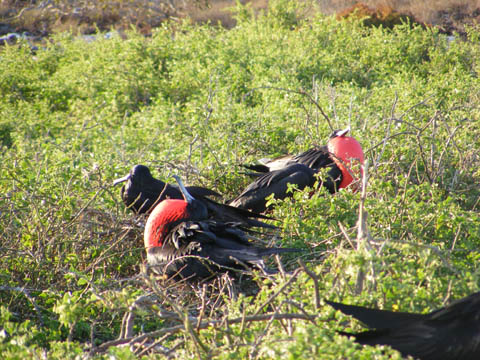
|
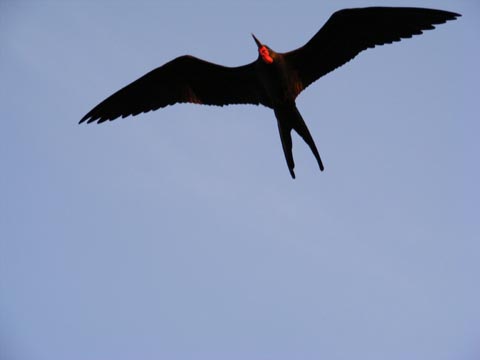
|
While we ate breakfast, La Fragata took us to the dock on Baltra for our flight back to Guayaquil.
Sea lions are not shy. Here they occupy two benches on the dock at Baltra.
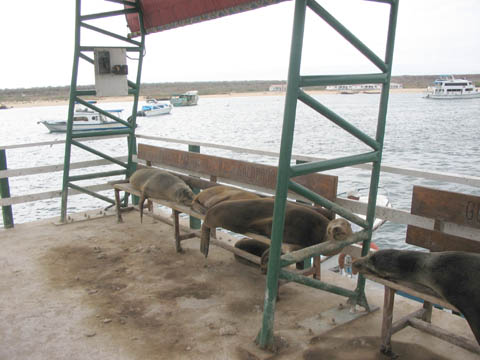
Back in Guayaquil, we had nearly two days before our flight home. Saturday morning we took a taxi to the Cerro Blanco Nature Preserve, which is about 15 kilometers out of town. We were the only visitors there, and we saw glimpses of a monkey, a rare Guayaquil woodpecker - it resembles our piliated woodpecker in size and color - and other birds. Most were too fast for us to photograph, but this tarantula posed for us. It was about as big as my hand.
We also attended a book fair, took an evening cruise on the river, attended Mass at the Guayaquil Cathedral, and visited the cemetery.

Thanks for visiting.
Created: 15 July 2007, Responsible: Albert Holm
Revised: 3 May 2025